Service hotline
+86 0755-83044319
release time:2022-03-17Author source:SlkorBrowse:11703
MOS transistor, the abbreviation of MOSFET, is spelled Metal-Oxide-Semiconductor Field-Effect Transistor, which translates to Metal-Oxide Semiconductor Field-Effect Transistor. According to different conductive channels, MOS can be subdivided into NMOS and PMOS.
The figure below is a schematic diagram of NMOS. As you can see from the red box in the figure, MOS has a diode connected in parallel between D and S poles. Some people say that this diode is a parasitic diode, while others say it is a body diode. Which statement is accurate? Many students are also very curious: Why connect this diode in parallel? Can it be deleted?
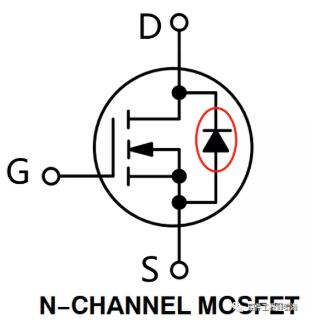
This should start with the process and structure of MOS. Both MOS and diode are made of semiconductor materials. We all know that diode is made of a pair of PN junctions. See the following figure. P-type region corresponds to the anode of diode, and N-type region corresponds to the cathode of diode.
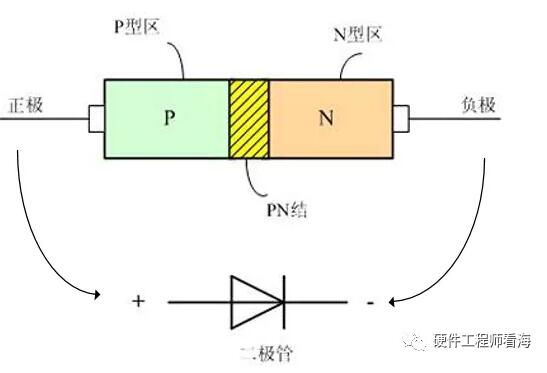
Looking back at the MOS structure, it can be seen from the following figure (1) that the oxide O in MOS refers to silicon dioxide SiO2, which is not conductive, so the driving electrode G basically does not run current, so the power consumption of MOS is relatively low, and it is a voltage-type driving device.
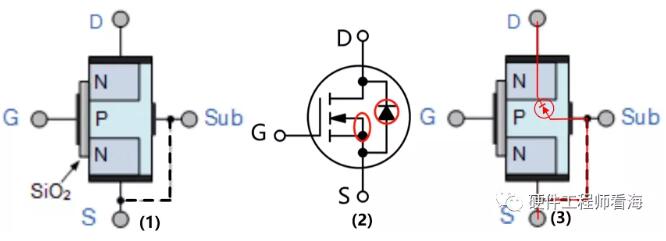
It can also be seen from
(1) that apart from the three poles D, G and S, MOS has a Sub pole, and the Sub and S poles are connected. Therefore,
(2) in the circuit symbols of MOS, the arrow pointing to the channel N in the MOS will be connected with the S pole (there is no love or hate for no reason in the world).It can be seen from
(3) that the N-type region-> the middle P-type region-> the ->Sub-pole-> the S-pole of the D-pole just forms a diode structure and is in the reverse bias state, which is why a diode is connected in parallel in the MOS symbol.From the above analysis, we can know that this diode is due to the MOS structure and technology. It is not appropriate to say that it is a parasitic diode, and the name of body-diode is relatively accurate.
So what's the use of this body diode? In some scenarios, it is undesirable to have this diode, which may lead to the possibility of leakage between the S-pole and the D-pole.
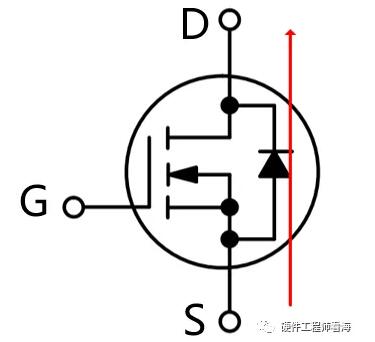
There is love and hate, and in other scenarios, this diode is used to make the system work normally. For example, I have written an article before: "Battery Protection 1: UVP Principle of Lithium Battery Overdischarge Protection", which is introduced. Some battery protection boards will turn on the protection function: turn off the discharge MOS after the lithium battery is over-discharged. When the charger is plugged in, the MOS body diode is used to make the circuit conductive and the system works normally.
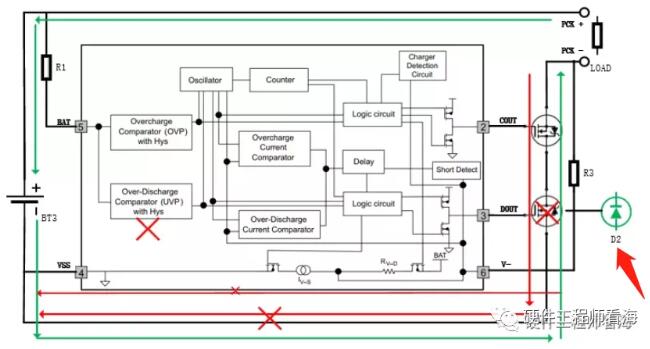
The above is the reason why MOS symbols are connected in parallel with diodes, and the introduction of their use.
Disclaimer: This article is reproduced from "Electronic Intelligence Manufacturing Industry". This article only represents the author's personal views, not the views of Sacco Micro and the industry. It is only for reprinting and sharing to support the protection of intellectual property rights. Please indicate the original source and author when reprinting. If there is any infringement, please contact us to delete it.
Company Tel: +86-0755-83044319
Fax/fax:+86-0755-83975897
Email: 1615456225@qq.com
QQ: 3518641314 Manager Li
QQ: 332496225 Manager Qiu
Address: Room 809, Block C, Zhantao Technology Building, No.1079 Minzhi Avenue, Longhua New District, Shenzhen









Site Map | 萨科微 | 金航标 | Slkor | Kinghelm
RU | FR | DE | IT | ES | PT | JA | KO | AR | TR | TH | MS | VI | MG | FA | ZH-TW | HR | BG | SD| GD | SN | SM | PS | LB | KY | KU | HAW | CO | AM | UZ | TG | SU | ST | ML | KK | NY | ZU | YO | TE | TA | SO| PA| NE | MN | MI | LA | LO | KM | KN
| JW | IG | HMN | HA | EO | CEB | BS | BN | UR | HT | KA | EU | AZ | HY | YI |MK | IS | BE | CY | GA | SW | SV | AF | FA | TR | TH | MT | HU | GL | ET | NL | DA | CS | FI | EL | HI | NO | PL | RO | CA | TL | IW | LV | ID | LT | SR | SQ | SL | UK
Copyright ©2015-2025 Shenzhen Slkor Micro Semicon Co., Ltd